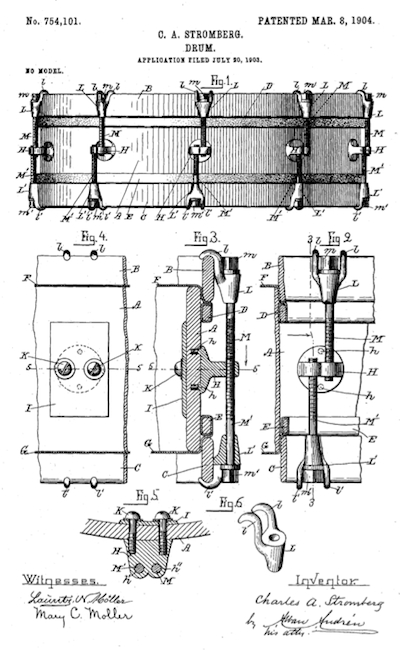Long before Charles and his youngest son Elmer would become famous for their big-body archtop guitars of the 1940s and 1950s, the elder Stromberg was catering to the needs of theater drummers in Boston's thriving Vaudeville scene. Today we take a look at a magnificent example of some of his very earliest independent work, a beautifully well preserved "Celebrated Stromberg Invincible Orchestra Drum" dated March, 30 1906.
 1906 Charles A. Stromberg Invincible Orchestra Drum 1906 Charles A. Stromberg Invincible Orchestra Drum |  The Music Trade Review - December, 1903 The Music Trade Review - December, 1903 |
This drum was in many ways a decade or two ahead of its time and at least lap ahead of the local field as no maker in New England was making anything like this at the turn of the 20th century. Emile Boulanger's Duplex Manufacturing Company of St. Louis had patented a separate tension lug in 1883, but drummers and other drum makers were slow to embrace the concept. In 1906, the lowly snare drum was still more than a decade from being fully modernized at the hands of companies such as Ludwig & Ludwig and Leedy during the 1920s. At the time when Stromberg built this drum, Ludwig & Ludwig had not even been founded yet.
Stromberg applied for a two patents pertaining to snare drum construction, both of which were applied to his Invincible Orchestra Drum. The first patent, applied for on July 20, 1903 and granted on March 8, 1904, involved the method by which the drum is tensioned using claws, tension rods, and separate tension lugs. The second patent, also applied for on July 20, 1903 and then granted on April 5, 1904, related to the snare throw-off and snare butt. A somewhat updated version of this design is present on this drum though the patent date is still stamped into both the snare butt and the bracket which clamps the snares into the throw-off. Presumably, Stromberg continued to evolve his design after submitting it to the patent office almost three years earlier.
 |  |
The significance of these patented designs cannot be understressed. The concept of separate tension, where either head can be tensioned independently of the other, was still a relatively new one at the turn of the 20th century and this drum was likely the first of its kind in Boston. And a fully functioning snare throw-off capable of not only tightening and loosening the snares, but fully engaging them with or releasing them completely from the bottom head with the turn of a single lever was almost unheard of at the time.
| Stromberg's background as a cabinet maker is clearly on full display here. A beautiful outer ply of birds-eye maple, a perfectly turned ebony grommet, and engraved, faux rosewood counter hoops are all examples of his impressive craftsmanship. Such touches were not uncommon in the early decades of the 1900s, but Stromberg's work is of exceptionally high quality. The counterhoops for example have been painted to resemble rosewood veneer and have then been scored or engraved with a series of lines as ornamentation. This also gives the drum a more high end look and even a certain lightness in appearance considering the height of the wooden hoops necessary to maintain tension on the heads. Stromberg drums in general have a certain elegance about them and that characteristic is certainly apparent here. Maybe the most astonishing feature of this drum is its staggered, THREE PLY maple shell with no reinforcing rings. Gretsch often claims that this is an innovation of their own dating from sometime in the 1920s and later popularized in the 1940s, but this drum provides us with hard evidence that Stromberg was forming such shells in his Boston workshop several decades earlier. |  |
Despite the rather rudimentary design of the separate tension lugs, they still have a certain low mass quality about them so as not to give the drum a bulky or heavy appearance. And the quality of construction in general is of the highest level. The three ply shell is as sturdy as the day it was built and the solid brass lugs, which maintain their bright nickel plating, function just as they should after 109 years.
The makers label present inside of the drum shell is significant in its own right. It is in fact a Thompson & Odell label that has been modified with what was apparently Stromberg's own address at the time, 767 Washington St., Boston, Mass., U.S.A. The handwritten date, March 30, 1906, positions this as one of the first drums made by Stromberg after his departure from Thompson & Odell upon their bankruptcy in 1905.
 |  |
 |  |
The drum is outfitted with period correct calfskin heads and what looks to be the original gut snares which are quite thin and of high quality. This instrument won't receive any playing time as it will be preserved purely as a historical collectible, but a few light taps on the head produce a surprisingly bright sound due to the shallow three inch shell depth and firm head tensioning provided by the design of the drum.
Do you have a drum made by Charles A. Stromberg? I want to hear from you! Feel free to drop Lee an email anytime at lee@vinson.net. And for more on the early 20th century snare drum makers of Boston, Massachusetts, please visit BostonDrumBuilders.com.
